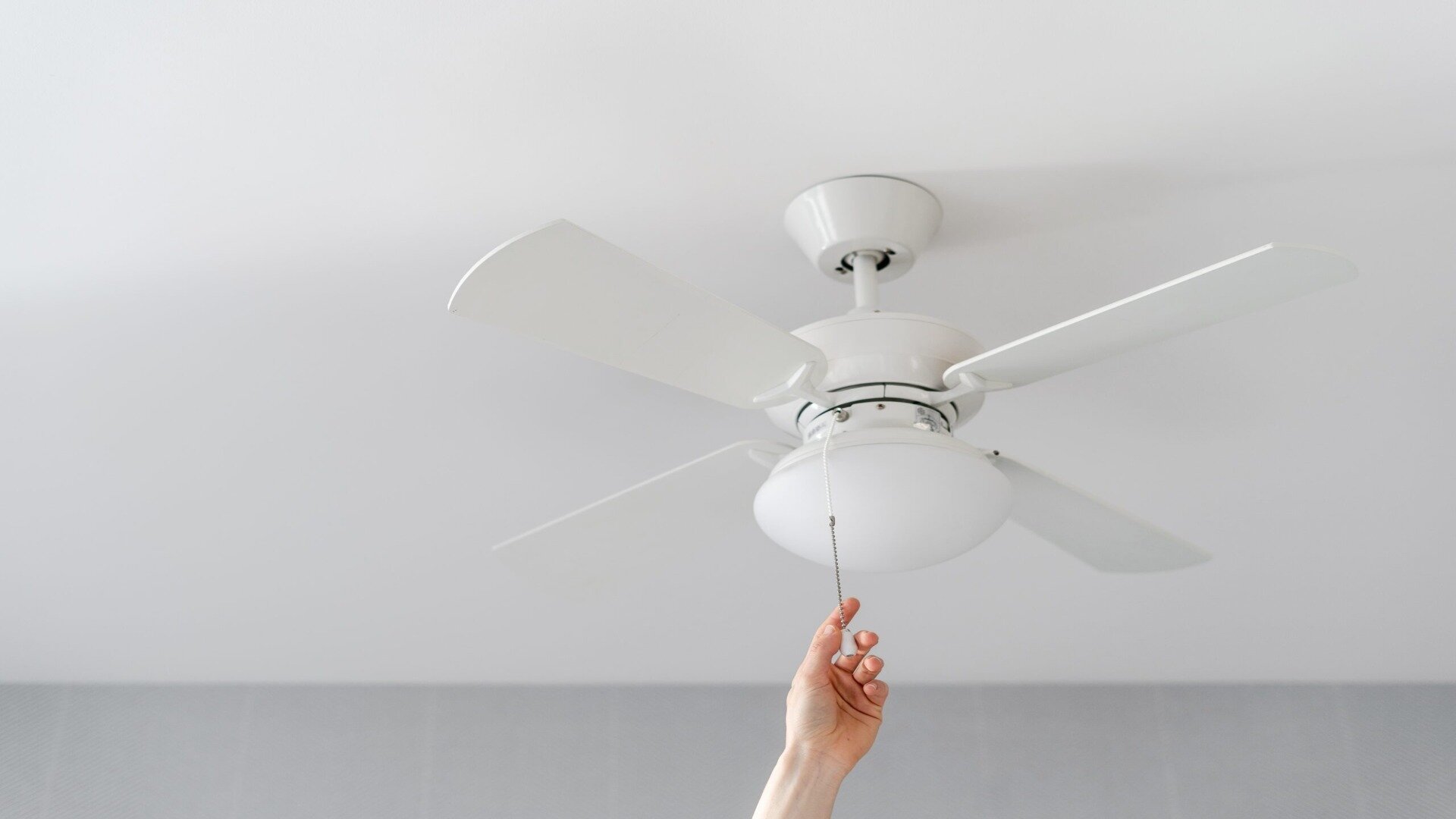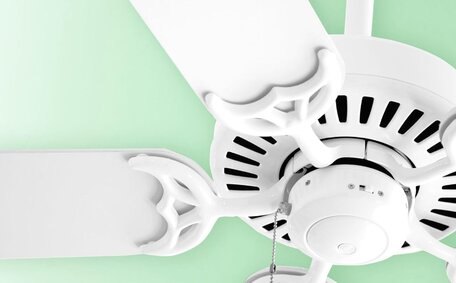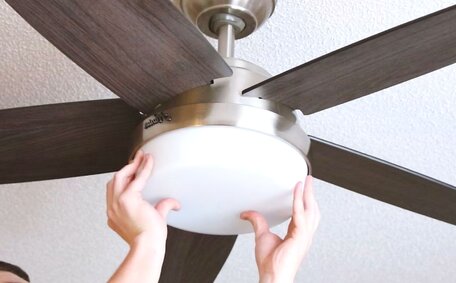![2023 11 Guy Fixing Ceiling Fan Guy Fixing Ceiling Fan]()
As the temperature rises this summer, ensuring your ceiling fan works efficiently can keep indoor spaces cool. But is your fan genuinely ready to tackle hot weather? While it may have provided airflow all winter, some maintenance is needed before summer heat arrives.
This guide is packed with tips to get the most out of your ceiling fan during the summer months. Simple steps, such as cleaning your blades and setting the right speeds, can really enhance air circulation and help cut costs. We’ll also touch on ensuring there’s enough clearance, adjusting the fan’s direction, and even integrating it with your thermostat. By following these strategies, you’ll keep your ceiling fan ready to beat the summer heat in no time.
1. Check Your Ceiling Fan Blades
One of the most important things you can do is clean your ceiling fan blades. Over time, dust and dirt particles accumulate on the blades, reducing their ability to move air around the room effectively. Take some time to wipe down each blade to remove any build-up.
Start by turning off the fan’s power for safety reasons. Next, grab a duster or soft cloth and gently clean both the top and bottom of each blade. Don’t forget to focus on the edges where dust tends to gather. If you spot stubborn dirt hiding in crevices, a small brush can come in handy to reach those spots.
Cleaning the blades will restore their aerodynamic properties so they can push air downward more efficiently. Dirty blades force the fan to work harder and move less air. Taking just 15-30 minutes to spruce them up can make a big difference in cooling performance over the summer months.
Consider inspecting blades twice during peak season - once halfway through summer. Recleaning midway will fight dust and ensure optimal airflow when it’s needed most on hot days. Clean blades are an easy way to get your ceiling fan fully summer-ready.
2. Adjust Fan Speed Settings
When the temperature rises, it’s important to increase the speed of your ceiling fan for increased airflow. Most modern fans have multiple speed options that are easy to control.
When it’s sweltering outside, crank your fan to the highest speed for that cooling breeze everyone craves. This creates a strong breeze that really helps keep you comfortable. As the nights get a bit cooler, you might find that a lower setting does the job just fine.
If you have a programmable fan, take advantage of its scheduling capabilities. You can set automated shifts to higher speeds during predicted warm parts of the day and leisurely speeds at night. This optimises cooling power without wasting energy when temperatures decrease.
Higher fan speeds on summer settings help sweat evaporate off your skin faster. The stronger breeze pulls heat away from your body more effectively. Just be sure not to position the fan over you, as too-direct airflow can feel uncomfortable.
3. Consider the Direction of Blade Rotation
The direction in which your ceiling fan’s blades spin can enhance or reduce its cooling capabilities. Most fans have a switch that reverses the rotation between clockwise and counterclockwise.
During those scorching summer months, flip your fan to rotate clockwise. This directs air downwards, creating a refreshing wind chill to keep things cooler below. In winter, switch it to counterclockwise, which is perfect for a gentle updraft to circulate warmer air.
Flip the switch when the seasons change so the fan’s air movement works in the outdoor climate. In summer, rotating clockwise draws warm air up toward the ceiling and pulls cooler air down at your level. This evaporation process allows the fan to boost cooling power when needed.
Blade rotation is important but often overlooked. Switching the direction setting ensures your fan circulates air optimally for summer comfort. Both you and your energy bills will thank you later!
![2023 11 White Ceiling Fan White Ceiling Fan]()
4. Look at Your Fan Light Kit
While you have the ceiling fan down for cleaning and maintenance, take a moment to inspect the integrated light kit as well. Over time, bulbs can burn out or flicker, diminishing light quality.
Test each light by turning the fan on and seeing if the bulbs glow brightly. Replace any that appear weak, burned out, or flickering. LED bulbs provide excellent illumination while using little power and producing minimal heat.
Think about swapping those old incandescent bulbs for ENERGY STAR-certified LEDs to really ramp up efficiency. It’s a small investment that pays off in the long run with a longer bulb life and lower energy bills all year round.
A ceiling fan is often used as a primary light source in some rooms, like bedrooms. Dull or flickering lights defeat that purpose. Taking a few minutes to check the light kit ensures your fan will provide adequate light during the late summer evenings.
Keeping bulbs in good working order is a simple summer prep step that boosts your fan’s functionality for cooler months. Bright, efficient lights are the icing on the maintenance cake.
5. Clear the Area Around Your Ceiling Fan
For a ceiling fan to work correctly, adequate clearance and open space beneath the fan blades are needed to circulate air effectively. Over time, the area below may collect dust or clutter that restricts airflow.
Ensure at least 7 feet of clearance under your ceiling fan. This allows the blades to spin unimpeded. Remove any obstructions, such as hanging plants, stored objects, or overhanging light fixtures, that enter the fan’s rotation zone.
Clear away any unnecessary furniture, boxes, or decor directly underneath to give your ceiling fan room to do its job. Air must be freely exchanged from floor to ceiling for maximum cooling power.
Keeping the area beneath the fan clear eliminates pesky turbulence, allowing it to operate more efficiently. With obstacles out of the way, your fan blades can smoothly guide air downward without interruption.
Five minutes to declutter the fan’s drop zone pays off, as it operates at total capacity all summer. Clear sailing means clear, cooling breezes where you need them most.
6. Tweak Your Thermostat Settings Accordingly
With your ceiling fans tweaked and ready, it’s time to think about your thermostat settings to make the most of their cooling power. You’ll often find that with fans spinning, you can raise the thermostat a notch or two instead of relying solely on the air-con.
On warm days, raise the thermostat to 2- 4°F higher than usual since ceiling fans create a stronger wind chill effect. The airflow helps you feel comfortable despite the slightly elevated indoor temperature.
This minor adjustment can save a significant amount on monthly cooling bills. Your air conditioner will run less frequently while ceiling fans do some work. Just be diligent about using fans continuously for the best results.
On milder days, open windows and use ceiling fans in cross-ventilation mode for free cooling. Thermostat adjustments allow dual fan-AC use, too, if extra help is needed on hot afternoons.
By optimising thermostat levels and freshly tuned ceiling fans, you can maximise comfort and energy savings during the summer months.
Maximise Your Ceiling Fan’s Cooling Power
With simple seasonal checks and adjustments, your ceiling fans can provide optimal air circulation to help beat the summer heat. Cleaning blades, resetting speeds and rotations, and clearing cluttered spaces will take just a few hours, and they will help your fans perform at their cooling best.
Be sure also to inspect light bulbs and integrate fans with thermostat settings. Following these routine maintenance tips means cooler indoor relief is just a breeze away.
If your ceiling fan needs repair or upgrade, consider contacting the experts at Bright Force Electrical. As a full-service electrical contractor, we can service any ceiling fan brand or install new energy-efficient models.
Bright Force Electrical is ready to ensure your fans stay summer-ready for many seasons. Call us today to discuss a ceiling fan consultation or service appointment. Keep cool this summer with ceiling fans at their maximum cooling potential!










